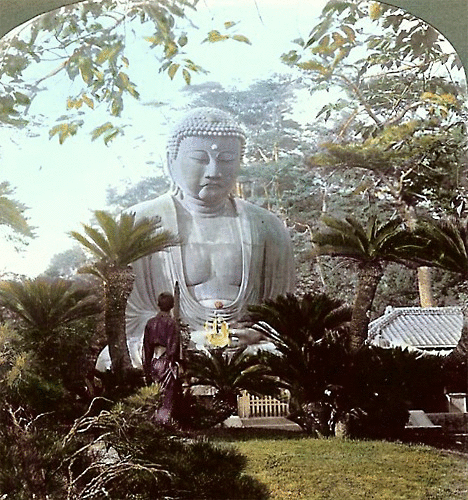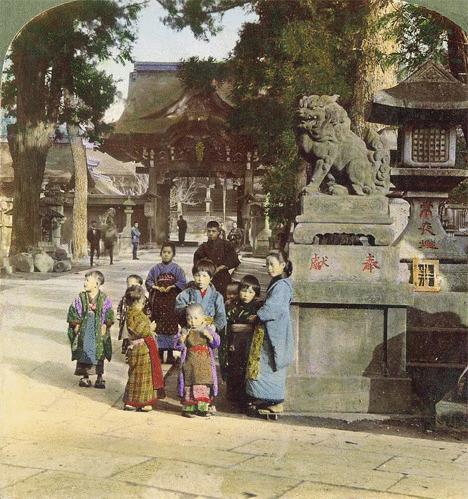
For about a quarter of a millennium, Japan had a policy called sakoku, literally meaning “closed country,” which put to death foreigners who dared enter to Japan, or Japanese who dared to leave it. It came to an end with the Meiji Restoration, the period between 1868 to 1912, during which Japan put the Emperor back in charge and, as historians often say, began to “open up” to the outside world, lighting out on the path to its own kind of modernity. Foreigners would still have had only a vague idea of Japanese life at the time — at least those without access to a stereoscope, and who thus couldn’t lay eyes on the vivid 3D photography of Yokohama’s T. Enami.

“To many whose lives revolved around photography — including both Japanese and foreign professionals, as well as serious amateurs — Enami was not just a photographer, but a ‘photographer’s photographer,’ ” writes Enami enthusiast Rob Oechsle on his site t‑enami.org. He also dubs his photographic hero (who was born Nobukuni Enami in 1859 and lived until 1929, seeing the end of the Meiji era but not the beginning of the second world war) “King of the Stereoview, Master of the Lantern-Slide, Prolific, Anonymous Contributor To the World of Meiji-era Yokohama Album Views, Dedicated Street Photographer, and Honored Alumnus of National Geographic Magazine.”

That first title has granted a portion of Enami’s large body of work a surprising recent afterlife. Following in his teacher’s footsteps, Enami refined the Japanese use of the stereographic camera, a device that produced, writes the Victoria and Albert Museum’s Zoe Clayton, a stereograph: “two pictures mounted next to each other, viewed with a set of lenses known as a stereoscope. Taken around 7cm apart, roughly corresponding to the spacing of the eyes, the left picture represents what the left eye would see, and likewise for the right, so when observing the pictures through a stereoscopic viewer, the pair of photographs converge into a single three-dimensional image.”

Advertised with slogans like “See the world from your parlor!,” this “optical marvel took the world by storm in the mid 19th century, becoming the first ever mass-produced photographic images sold,” their popularity such that “every Victorian home — regardless of class — had a stereoscope and a collection of views.” And though the years have made stereoscopes a little hard to come by, the internet has discovered that you can enjoy something like the same 3D effect Victorian viewers did by looking at an animated GIF that oscillates quickly between the left picture and the right one. Enami hand-tinted many of his stereographs, resulting in colored historical images that look, even in two dimensions, startlingly realistic today.

Here we present only a few of Enami’s stereographs, but you can see a much fuller collection at Oeschle’s “Old Japan in 3D” Flickr page. He survived 1923’s Great Kantō earthquake, but his studio didn’t; he rebuilt it and later passed it on to his son, who ran the place until it underwent a second destruction in 1945 by Allied bombs. Though Enami’s name remains known primarily to fans of Meiji-era photography, his posthumous reputation has slowly but steadily grown: one of his photos even appeared on the cover of the first edition of Odyssey: the Art of Photography at National Geographic. These GIFs have already sparked an interest in Enami’s work among a new generation. When 3D monitors catch on, perhaps he’ll rise to his true place in the photographic pantheon.
via Boing Boing
Related Content:
Hand-Colored 1860s Photographs Reveal the Last Days of Samurai Japan
Hand-Colored Photographs of 19th Century Japan
Advertisements from Japan’s Golden Age of Art Deco
Glorious Early 20th-Century Japanese Ads for Beer, Smokes & Sake (1902–1954)
Early Japanese Animations: The Origins of Anime (1917–1931)
A Photographic Tour of Haruki Murakami’s Tokyo, Where Dream, Memory, and Reality Meet
Based in Seoul, Colin Marshall writes and broadcasts on cities and culture. He’s at work on a book about Los Angeles, A Los Angeles Primer, the video series The City in Cinema, the crowdfunded journalism project Where Is the City of the Future?, and the Los Angeles Review of Books’ Korea Blog. Follow him on Twitter at @colinmarshall or on Facebook.


This a little close to animated earthquake photography.
These are lovely, but in what historical sense do they show 1850s Japan? Enami wasn’t born until 1859, as you say in the article, and the first surviving photos of Japan were not taken until 1861. These photos probably capture 1870s or 1880s Japan, and are no less marvellous because of that. Wonderful things like Enami’s work do not require journalistic fibs to make them more wonderful.